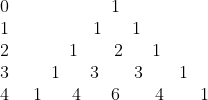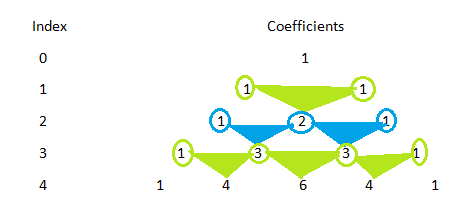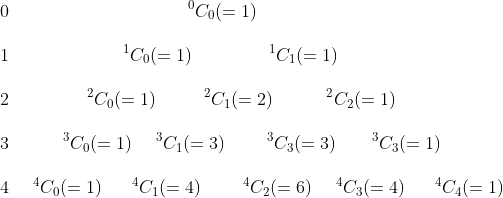JEE Main Important Physics formulas
ApplyAs per latest 2024 syllabus. Physics formulas, equations, & laws of class 11 & 12th chapters
Binomial Theorem belongs to the 8 chapter of NCERT. The NCERT Class 11 Maths chapter 8 notes entirely cover up the main portions of the chapter Binomial Theorem. In the introduction Binomial Theorem Class 11 notes we will learn about how we can find an expanded form of an expression with an index. Binomial Theorem Class 11 notes describe how we get pascal’s triangle from the expansion of ![]() where n=1, 2, 3. Class 11 Math chapter 8 notes cover the main topics that are a number of terms of an expansion, how to use combination formula to the expanded form, the middle term of
where n=1, 2, 3. Class 11 Math chapter 8 notes cover the main topics that are a number of terms of an expansion, how to use combination formula to the expanded form, the middle term of ![]() when n is an even or odd.
when n is an even or odd.
JEE Main Scholarship Test Kit (Class 11): Narayana | Physics Wallah | Aakash | Unacademy
Suggested: JEE Main: high scoring chapters | Past 10 year's papers
New: Aakash iACST Scholarship Test. Up to 90% Scholarship. Register Now
A Class 11 Math chapter 6 notes help you to find the entire chapter in an easy way. NCERT Notes for Class 11 Maths chapter 6 not only covers the NCERT notes but covers CBSE Class 11 Maths chapter 8 notes also.
After going through Class 11 Binomial Theorem notes
Students can also refer to,
We know,
![]()
![]()
![]()
![]()
If we observe each expansion,
The total number of terms of each expansion is 1 more than the index of![]() .
.
In the expansion, the power of the first quantity is gradually decreasing that is by 1 and the power of the second quantity is gradually increased that is by 1.
Suppose n is the index of ![]() , then the sum of indices of a and b of each term of the expansion is n.
, then the sum of indices of a and b of each term of the expansion is n.
Now arranging of the coefficients of expansion with respect to their index
Index Coefficients

If we observe the pattern we can get the coefficient of the next index.
The pattern is given below

Figure: 1
This diagram is known as Pascal’s triangle.
If we apply Pascal’s triangle rule, then the coefficients of ![]() will be
will be
1 5 10 10 5 1
Similarly, the coefficient of ![]() will be
will be
1 6 15 20 15 6 1
Now we can apply the combination formula to find the coefficients.
Binomial coefficient (for a Positive integral index n )![]() where n and r are a positive integer and
where n and r are a positive integer and ![]() .
.
Figure 2 can be rewritten as
Index Coefficients

Binomial Theorem:
Binomial theorem for any positive integer n
![]()
Proof:
We will proof the theorem by using principal induction.
Let ![]()
Putting ![]()
![]()
![]()
For ![]() it is true.
it is true.
Assume that it is true for ![]()
![]()
We will prove that ![]() i.e
i.e![]() is true by using
is true by using![]() .
.
Now, ![]()
![]()

Add like terms

Now apply the formula![]() ,
,![]() , and
, and ![]()
![]()
Hence proved.
Properties of Binomial coefficient
1. ![]()
2. ![]()
![]()
and

hence prove both are equal.
3. If ![]() only if
only if ![]() and
and ![]()
4. ![]()
5. If n is a positive integer and x, y are two complex numbers, then ![]()
Here are binomial coefficients. ![]()
6. Total no. of terms of the given as (n + 1) in the expansion
![]()
To find the middle terms of using the binomial theorem
The general equation of the binomial is given as
![]()
![]()
There are two case
If n is odd
The number of terms of ![]() when
when ![]() is an odd number is
is an odd number is![]() . Here
. Here ![]() is an even number. So there will be two middle terms. That are
is an even number. So there will be two middle terms. That are ![]() and
and ![]() of the expansion.
of the expansion.
If n is even
The number of terms of ![]() when
when ![]() is an eve number is
is an eve number is![]() . Here
. Here ![]() is an odd number. So there will be one middle term. That is
is an odd number. So there will be one middle term. That is ![]() of the expansion.
of the expansion.
To find the sum of the coefficient of the binomial terms we have to put the value of x numerical is one.
For example
Q if the binomial express is ![]() then find the sum of the binomial coefficient is?
then find the sum of the binomial coefficient is?
Solution:- Write the given expression ![]() now we have to put the value of
now we have to put the value of ![]() and get The coefficient sum =
and get The coefficient sum =![]()
= ![]()
= 1
So Sum of the binomial coefficient is 1.
Some Properties of the Binomial coefficients
![]()
Put ![]()

![]()
Put![]()

Some Particular expansions

Significance of NCERT Class 11 Math Chapter 8 Notes
Class 11 Binomial Theorem notes will be really helpful to revise the chapter and get a brief overview of the important topics. Also, notes for Class 11 Maths chapter 8 is useful for covering Class 11 CBSE Maths Syllabus and also for competitive exams like BITSAT, and JEE MAINS. Class 11 Maths chapter 8 notes pdf download can be used for preparing in offline mode.
Binomial Theorem Class 11 notes pdf download: link
NCERT Class 11 Maths Chapter 8 Notes |
Binomial Theorem is an expression to find the what is next terms of the higher-order polynomial equation.
It is the most often used in solving many real-life problems to find the reminder of the polynomial.
Class 11 Math chapter 8textbook should be followed.
The notes can be downloaded from the Binomial Theorem Class 11 notes pdf download.
Class 11 Binomial Theorem Notes help students to revise their important topics and score good marks in exams.

As per latest 2024 syllabus. Physics formulas, equations, & laws of class 11 & 12th chapters

Get up to 90% scholarship on NEET, JEE & Foundation courses

As per latest 2024 syllabus. Chemistry formulas, equations, & laws of class 11 & 12th chapters

Enrol in PACE IIT & Medical, Financial District, Hyd for JEE/NEET preparation

Start your JEE preparation with ALLEN

Ace your NEET preparation with ALLEN Online Programs